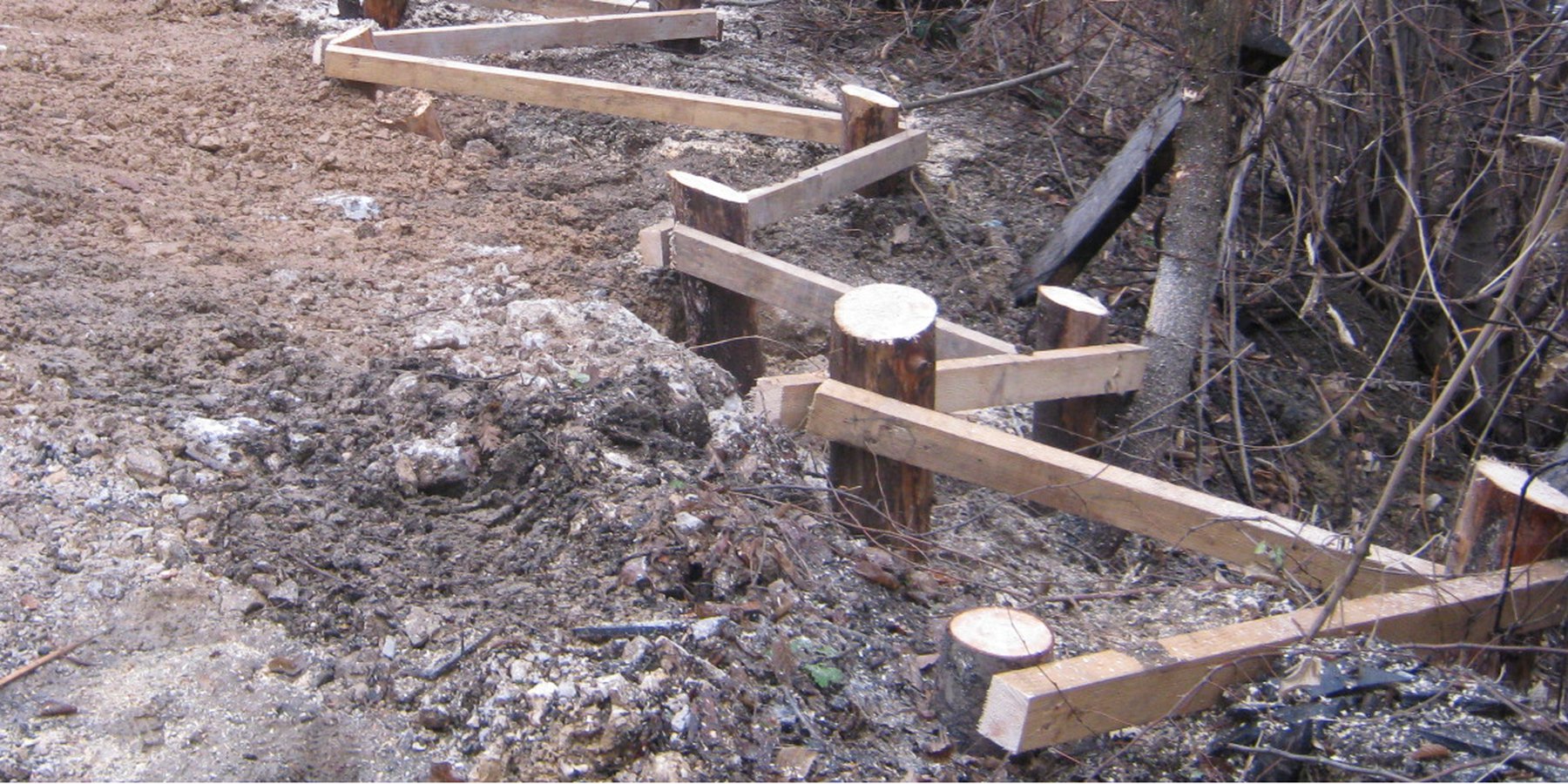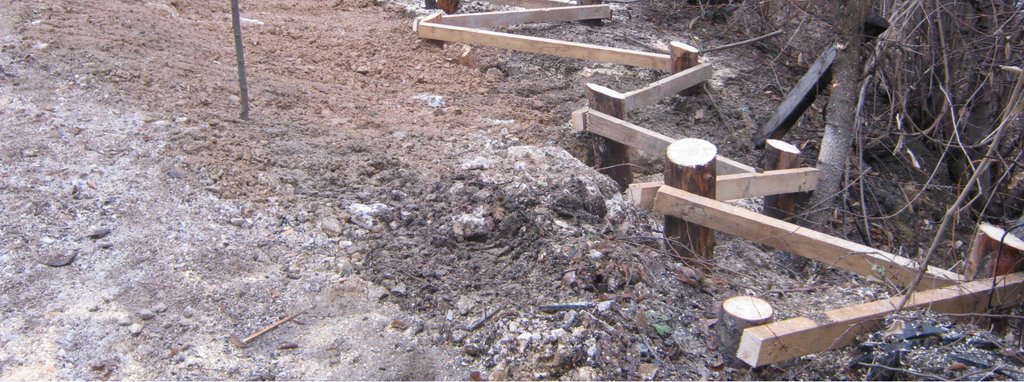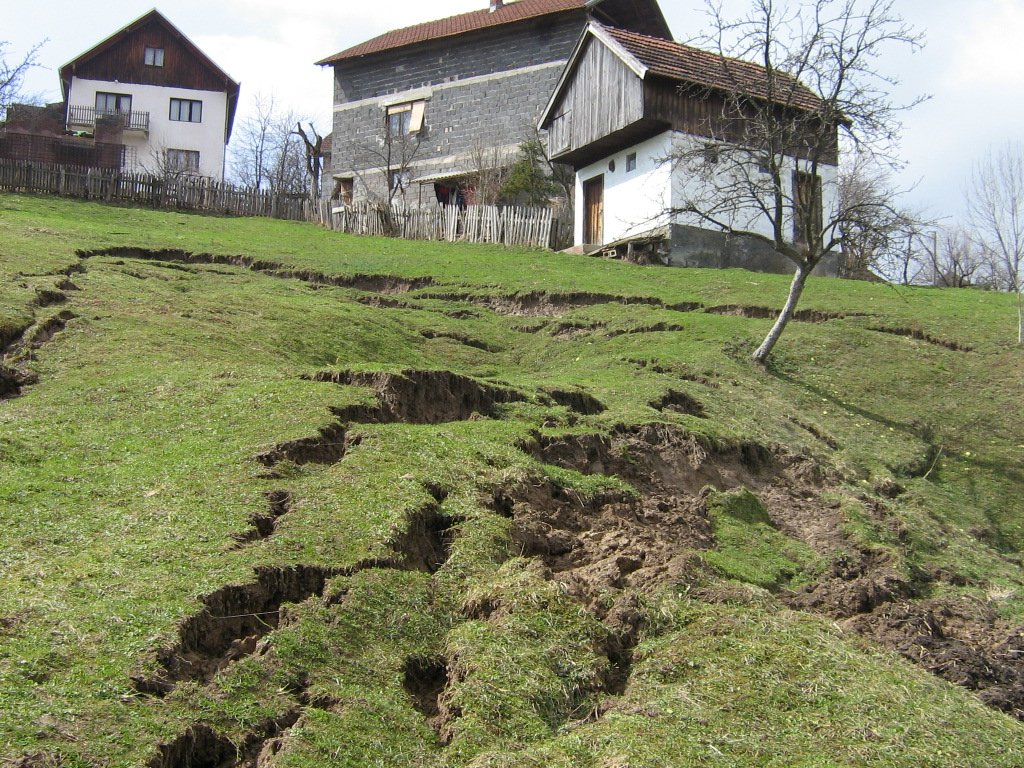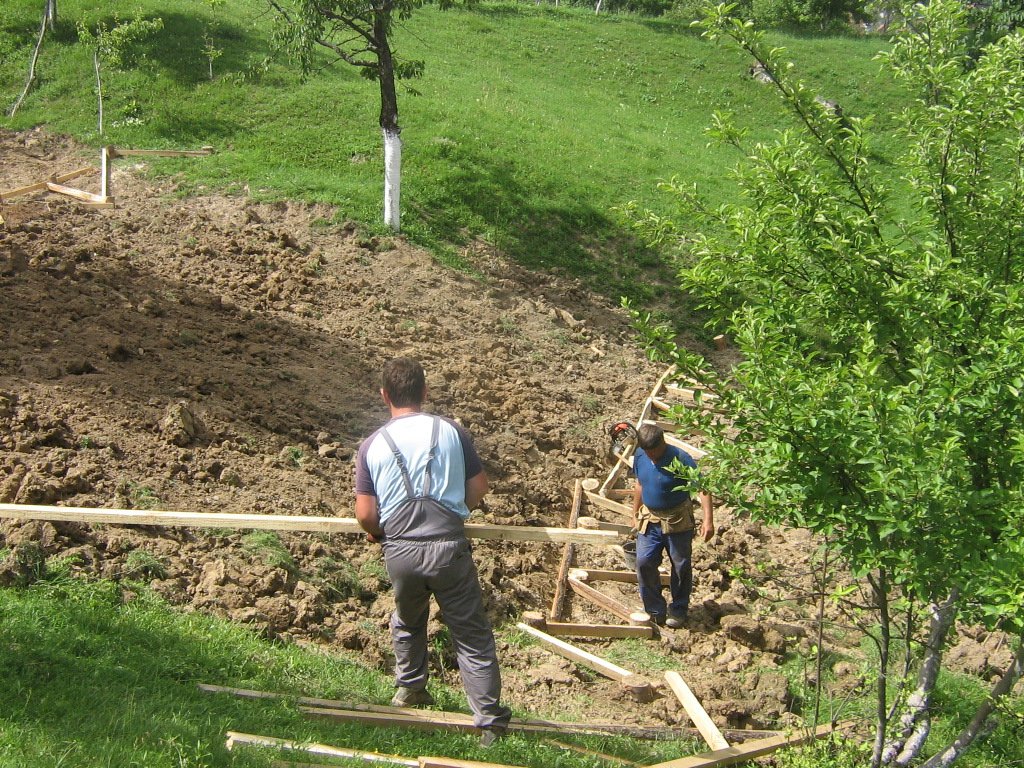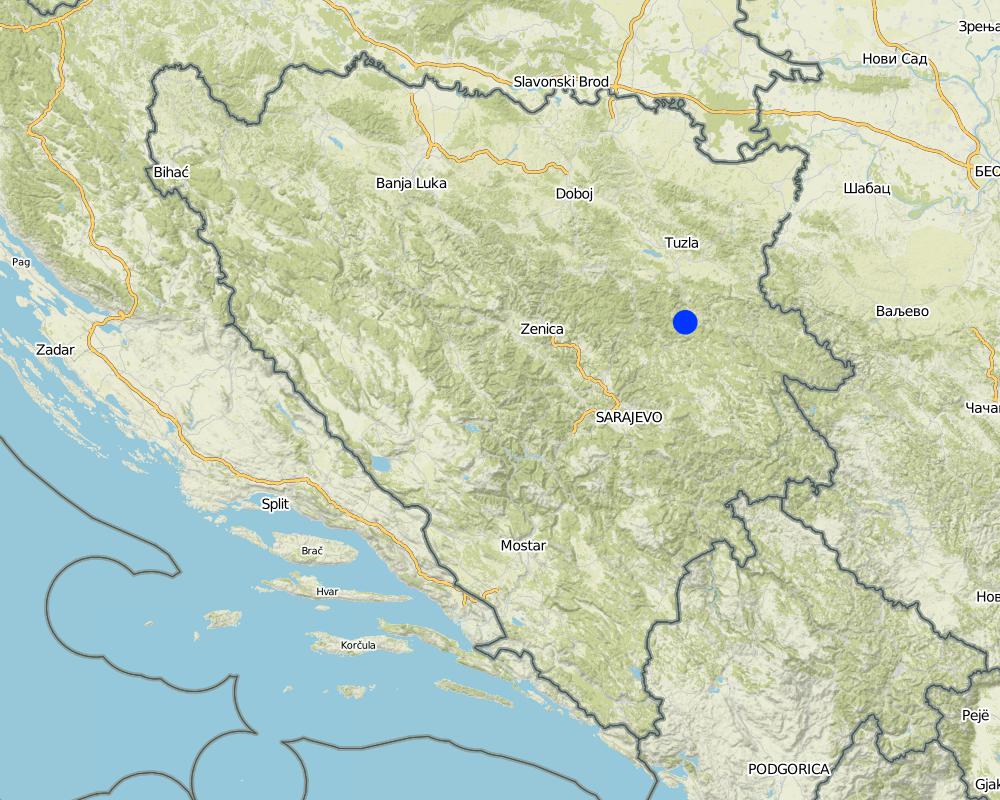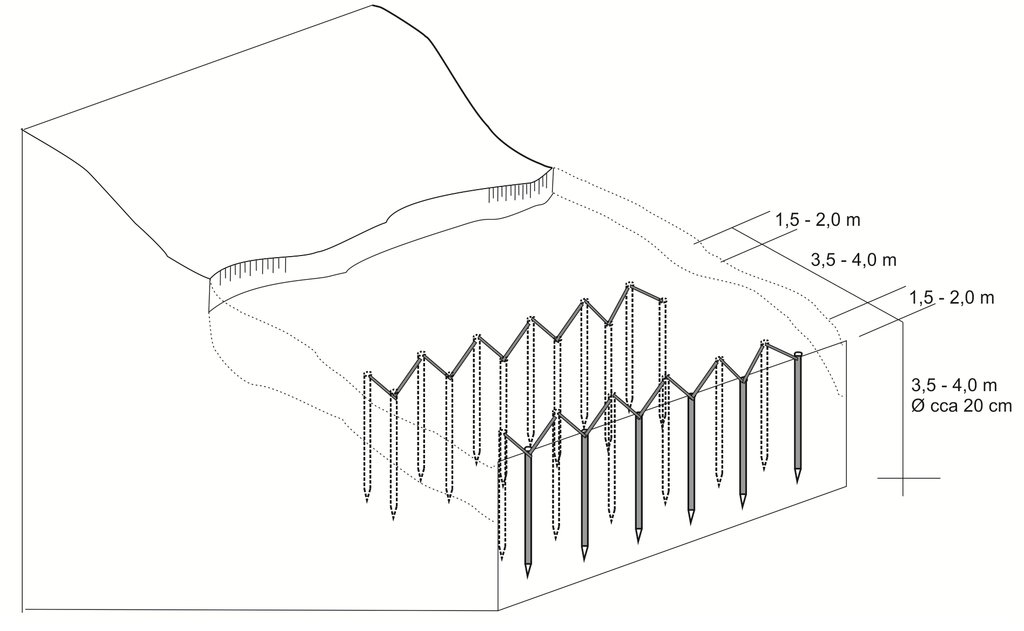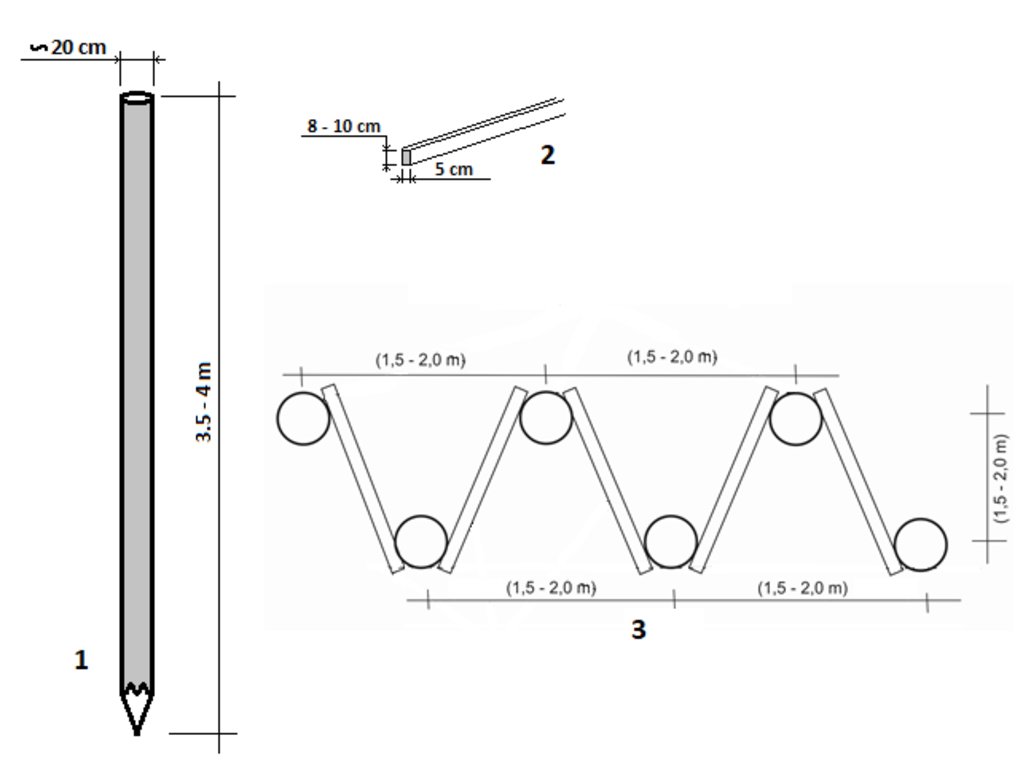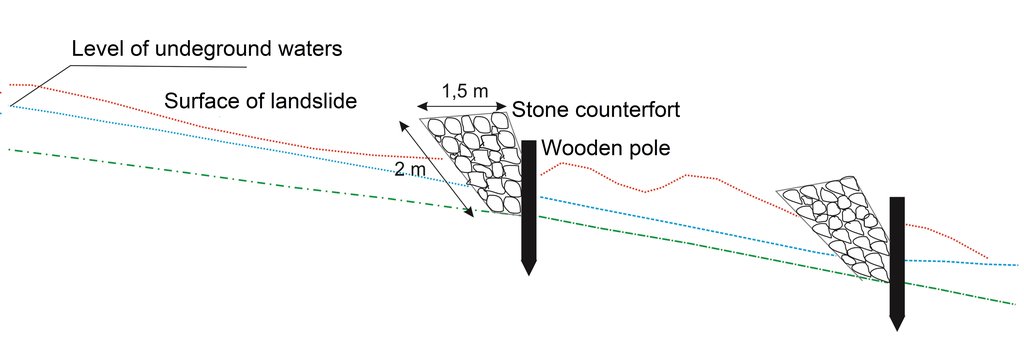Addressing shallow landslides by using wooden pole structures. [波斯尼亚和黑塞哥维那]
- 创建:
- 更新:
- 编制者: Milenko Blesić
- 编辑者: –
- 审查者: Donia Mühlematter, Rima Mekdaschi Studer, THEODORA FETSI
Zaustavljanje plitkih klizišta drvenim šipovima
technologies_4285 - 波斯尼亚和黑塞哥维那
查看章节
全部展开 全部收起1. 一般信息
1.2 参与该技术评估和文件编制的资源人员和机构的联系方式
SLM专业人员:
SLM专业人员:
Čustović Hamid
University of Sarajevo, Faculty of Agriculture and Food Sciences
波斯尼亚和黑塞哥维那
SLM专业人员:
Bajrić Muhamed
University of Sarajevo, Faculty of Forestry
波斯尼亚和黑塞哥维那
Municipality Kladanj Agronomist:
Hajdarević Hajda
Department of Finance, Entrepreneurship and Local Economic Development, Municipality of Kladanj
波斯尼亚和黑塞哥维那
土地使用者:
Hotović Huso
Land user, Borak Locality, Kladanj Municipality
波斯尼亚和黑塞哥维那
有助于对技术进行记录/评估的项目名称(如相关)
Decision Support for Mainstreaming and Scaling out Sustainable Land Management (GEF-FAO / DS-SLM)1.3 关于使用通过WOCAT记录的数据的条件
编制者和关键资源人员接受有关使用通过WOCAT记录数据的条件。:
是
1.4 所述技术的可持续性声明
这里所描述的技术在土地退化方面是否存在问题,导致无法被认为是一种可持续的土地管理技术?:
否
2. SLM技术的说明
2.1 技术简介
技术定义:
Utilization of wooden pole structures placed in parallel, to reduce shallow landslides (2-3 m) in relatively small surfaces. Possibility to be combined with drainage system for better results.
2.2 技术的详细说明
说明:
Farmers in northeast parts of Bosnia and Herzegovina traditionally applied the technology to address shallow landslides, surface erosion or loss of top soil due to sheet or interrill erosion. Movements of the upper layers of the soil appears due to unfavorable properties of the soil layers (clays, pseudoclays), set on impermeable geological substrates, all under conditions of intense and long-term rainfall. During the last decades, it has been frequently applied in the area of Kladanj municipality, whose administrative services for agriculture and forestry technically specified and promoted the technology. Landslides are one of the major problems in the hilly areas of Bosnia and Herzegovina, threatening particularly the agricultural lands. The technology is being applied by farmers on their own properties, but it is also part of public interventions, e.g. for the protection of roads or other infrastructure from landslides or in the context of roads recovery programs damaged by landslides. The technology aims to reduce the impact of the shallow (up to 2 - 3 m in depth) landslides of relatively small surface, by preventing further movement of the soil. So far, it is sporadically applied on around 20 – 30 locations in Kladanj Municipality, whose territory is around 355 sq. kilometers.
The technology implies pounding wooden poles in front (below) of the frontline of the landslide, along the contour, perpendicular to the slope. Land users recommend oaken pols due to their durability. The poles are usually 3.5 – 4 m long and 20 – 30 cm in diameter. One pole formation consists of two parallel lines of poles, with 1.5 to 2 m distance from line to line. The poles are positioned in a staggered way that a zigzag is formed. The poles are interconnected with wooden laths. One pole formation is usually enough to address smaller landslides, but in case of larger landslides, two formations are recommended. In the latter case, in combination with a drainage system, stone counterforts are formed in front (above) the poles' formation. See technical drawing for more details.
The primary purpose of the technology is to recover shallow and small landslides on slopping terrains. Stopping the movement of agricultural land after reparation of cracks and land gaps caused by landfall enables re-utilization of the land for either agricultural production or agro-forestry. In the municipality of Kladanj walnuts or other wooden fruit species with strong roots are often planted on recovered landslides.
After a prior assessment of the depth and surface of the landslide, an expert or a technician prepares simple project sketches. The sketches define configuration of pole formations and materials needed for the construction (oak poles, laths). The realization of the technology is not particularly demanding. Nowadays machines are used to pound poles in the ground (mainly by a dredge's spoon).
It is a relatively inexpensive technology which could be financed by even small farmers who can protect or recover their, under Bosnia and Herzegovina conditions, usually small agricultural land parcels.
Although not an integral part of the technology, modification with water drainage from the body of bigger landslide ensures additional, long lasting stability of the terrain. If performed, the drainage is carried out by depositing drainage material (perforated pipes, pebbles, tiny stone fractions) in the lower zone of drainage trenches whose configuration and depth depends on the terrain conditions. Another modification of the technology could include construction of a stone counterfort in front (above) the pole formation. These modifications are briefly presented in the technical specification of the technology, but they were not applied on the site (Borak locality) where activities, establishment and maintenance costs of the technology were observed.
2.3 技术照片
2.5 已应用该技术的、本评估所涵盖的国家/地区/地点
国家:
波斯尼亚和黑塞哥维那
区域/州/省:
Tuzla canton
有关地点的进一步说明:
Kladanj municipality
具体说明该技术的分布:
- 适用于特定场所/集中在较小区域
技术现场是否位于永久保护区?:
否
Map
×2.6 实施日期
如果不知道确切的年份,请说明大概的日期:
- 10-50年前
2.7 技术介绍
详细说明该技术是如何引入的:
- 作为传统系统的一部分(> 50 年)
3. SLM技术的分类
3.1 该技术的主要目的
- 减少、预防、恢复土地退化
- 降低灾害风险
3.2 应用该技术的当前土地利用类型
同一土地单元内混合使用的土地::
否

农田
- 一年一作
- 乔木与灌木的种植
年作 - 具体指明作物:
- 谷物类 - 玉米
- 谷类 - 其他
- 饲料作物 - 苜蓿
- 饲料作物 - 其他
- 蔬菜 - 其他
- Apples, Plums, Pears, Berry fruits
每年的生长季节数:
- 1
采用间作制度了吗?:
是
如果是,说明哪些作物是间作的:
Vegetables in orchards

牧场
粗放式放牧:
- 经营牧场
集约放牧/饲料生产:
- 改良牧场
动物类型:
- 牛 - 奶制品
- 牛 - 非奶牛牛肉
- 绵羊
是否实行作物与牲畜的综合管理?:
否
产品和服务:
- 肉类
- 奶类

定居点、基础设施
- 交通:公路、铁路
注释:
The technology could be applied on various types of land use. In the northeast region of Bosnia and Herzegovina it is commonly applied on: grazing land, cropland (annual, perennial, trees and shrubs), and mixed land uses. In Kladanj municipality the technology is frequently applied for protection or reconstruction of roads damaged by landslides.
3.3 由于技术的实施,土地使用是否发生了变化?
由于技术的实施,土地使用是否发生了变化?:
- 否(继续问题3.4)
同一土地单元内混合使用的土地::
否
3.4 供水
该技术所应用土地的供水:
- 雨养
3.5 该技术所属的SLM组
- 横坡措施
- stopping landslides, recovery of landslides
3.6 包含该技术的可持续土地管理措施

结构措施
- S3:分级沟渠、渠道、水道
- S6:墙、障碍物、栅栏、围墙
3.7 该技术强调的主要土地退化类型

土壤水蚀
- Wm:块体运动/滑坡
3.8 防止、减少或恢复土地退化
具体数量名该技术与土地退化有关的目标:
- 减少土地退化
- 修复/恢复严重退化的土地
4. 技术规范、实施活动、投入和成本
4.1 该技术的技术图纸
技术规范(与技术图纸相关):
The sketch depicts the cross-section of the terrain, illustrating the wooden poles’ structures and the technical characteristics of the technology. Two wooden structures are being placed in parallel, at a distance of 3.5-4 m. Each structure is consisted by wooden poles positioned in a zigzag form. The poles are pounded in the ground at a depth of 3.5 m and are connected to each other with wooden laths. The distance between the poles is 1.5-2 m. The number of poles to be used, depends on the size of the area where the intervention is needed. The recommended distance between the two parallel structures is 3 – 4 m, depending on the characteristics of the terrain.
The implementation of the technology does not bring any change on the slope and could be applied on various slopes. The technology is mostly applied on agricultural or infrastructural land, i.e. on slopes not above 30%.
作者:
Muhamed Bajrić, Milenko Blesić
日期:
20/10/2018
技术规范(与技术图纸相关):
Drawing 1 shows the recommended dimensions of the poles.Drawing 2 illustrates the technical characteristics of the laths (2) which connect the poles. Drawing 3 shows the top view of the overall structure with the required dimensions.
作者:
Milenko Blesić, Muhamed Bajrić
日期:
20/10/2018
技术规范(与技术图纸相关):
Modification (improvement) of the technology with a drainage system. The modification (drainage) was not applied on the site where the technology was observed.
作者:
Muhamed Bajrić
日期:
10/11/2018
技术规范(与技术图纸相关):
Modification (improvement) of the technology by construction of the stone counterforts just above the line of poles. The modification (stone counterforts) was not applied on the site where the technology was observed.
作者:
Muhamed Bajrić
日期:
10/11/2018
4.2 有关投入和成本计算的一般信息
具体说明成本和投入是如何计算的:
- 每个技术单元
指定单位:
Landslide on Borak locality - Kladanj municipalitay
指定单位面积(如相关):
0,35 ha
具体说明成本计算所用货币:
- 美元
注明雇用劳工的每日平均工资成本:
29.24 USD
4.3 技术建立活动
| 活动 | 时间(季度) | |
|---|---|---|
| 1. | Expert's characterization of landslide | Any time |
| 2. | Designing the structure and identifying the materials | Any time |
| 3. | Purchase and transport of materials (poles, laths) | Any time |
| 4. | Pounding poles in the ground | Spring - autumn |
| 5. | Connection of poles' heads (above ground parts) with laths | Spring - autumn |
| 6. | Machine leveling of the terrain | Spring - autumn |
| 7. | Planting of walnut seedlings | Autumn |
注释:
Establishment activities are presented in accordance withe the activities on one specific (Borak) locality. The surface of landslide on this locality was around 0,35 ha, and after its stopping with the formation of wooden poles, its full recovery was done by leveling of the terrain and planting of 300 walnut seedlings (further walnut orchard). The list of final recovery activities could be different on other localities and it depends of landowners' intentions and financial possibilities.
4.4 技术建立所需要的费用和投入
| 对投入进行具体说明 | 单位 | 数量 | 单位成本 | 每项投入的总成本 | 土地使用者承担的成本% | |
|---|---|---|---|---|---|---|
| 劳动力 | Expert's characterization of landslide, designing of construction, specification of materials | Working day | 2.0 | 100.0 | 200.0 | 100.0 |
| 劳动力 | Pounding the poles into the ground | Working day | 10.0 | 29.24 | 292.4 | 100.0 |
| 劳动力 | Connecting poles with lathes | Working day | 1.0 | 29.24 | 29.24 | 100.0 |
| 劳动力 | Planting of walnut seedlings | Working day | 10.0 | 29.24 | 292.4 | 100.0 |
| 设备 | Heavy machinery (dredge) work on pounding poles into the ground (hired) | Hour | 16.0 | 46.78 | 748.48 | 30.0 |
| 设备 | Heavy machinery (dredge) work on leveling of terrain | Hour | 4.0 | 46.78 | 187.12 | 30.0 |
| 植物材料 | Walnut seedlings | Piece | 300.0 | 2.92 | 876.0 | 30.0 |
| 施工材料 | Wooden (oak) poles | Piece | 100.0 | 17.5 | 1750.0 | 30.0 |
| 施工材料 | Wooden connecting laths | m | 200.0 | 0.5 | 100.0 | 30.0 |
| 施工材料 | Other auxiliary materials (nails, wire, etc.) | Lump sum | 1.0 | 12.0 | 12.0 | 100.0 |
| 技术建立所需总成本 | 4487.64 | |||||
| 技术建立总成本,美元 | 4487.64 | |||||
如果土地使用者负担的费用少于100%,请注明由谁负担其余费用:
So far, introduction of the technology in Kladanj municipality is supported from the municipality's budget (contribution in purchase of materials and hiring of heavy machinery).
注释:
The presented activities and costs are related to the landslide (0,35 ha) on Borak (Kladanj municipality) locality. On this particular site, the technology is applied without drainage system and stone counterforts next to wooden pole lines. Though they are not linearly connected, costs on other sites may be smaller or higher, depending on the size of landslides and concrete conditions on the ground.
4.5 维护/经常性活动
注释:
After establishment, the technology does not need any particular maintenance activities.
4.6 维护/经常性活动所需要的费用和投入(每年)
注释:
Due to the fact that after establishment the technology does not need any major maintenance activities, there are not any significant costs for maintenance. The maintenance is limited to annual checking of joints between lathes and poles and necessary minor interventions (replacement of possibly damaged lathes, re-connection of laths).
4.7 影响成本的最重要因素
描述影响成本的最决定性因素:
Prices of the construction materials (poles, laths).
Hiring costs of heavy machinery (dredge).
5. 自然和人文环境
5.1 气候
年降雨量
- < 250毫米
- 251-500毫米
- 501-750毫米
- 751-1,000毫米
- 1,001-1,500毫米
- 1,501-2,000毫米
- 2,001-3,000毫米
- 3,001-4,000毫米
- > 4,000毫米
指定年平均降雨量(若已知),单位为mm:
894.00
有关降雨的规范/注释:
The highest precipitations appear during spring and early summer, (June 111 L/m2; February 55 L/m2). Heavy downpours during summer is one of the climatic features of this area.
注明所考虑的参考气象站名称:
Tuzla
农业气候带
- 半湿润
5.2 地形
平均坡度:
- 水平(0-2%)
- 缓降(3-5%)
- 平缓(6-10%)
- 滚坡(11-15%)
- 崎岖(16-30%)
- 陡峭(31-60%)
- 非常陡峭(>60%)
地形:
- 高原/平原
- 山脊
- 山坡
- 山地斜坡
- 麓坡
- 谷底
垂直分布带:
- 0-100 m a.s.l.
- 101-500 m a.s.l.
- 501-1,000 m a.s.l.
- 1,001-1,500 m a.s.l.
- 1,501-2,000 m a.s.l.
- 2,001-2,500 m a.s.l.
- 2,501-3,000 m a.s.l.
- 3,001-4,000 m a.s.l.
- > 4,000 m a.s.l.
说明该技术是否专门应用于:
- 不相关
5.3 土壤
平均土层深度:
- 非常浅(0-20厘米)
- 浅(21-50厘米)
- 中等深度(51-80厘米)
- 深(81-120厘米)
- 非常深(> 120厘米)
土壤质地(表土):
- 中粒(壤土、粉土)
土壤质地(地表以下> 20厘米):
- 细粒/重质(粘土)
表土有机质:
- 中(1-3%)
5.4 水资源可用性和质量
地下水位表:
表面上
地表水的可用性:
中等
水质(未处理):
仅供农业使用(灌溉)
水质请参考::
地表水
水的盐度有问题吗?:
否
该区域正在发生洪水吗?:
是
规律性:
偶然
5.5 生物多样性
物种多样性:
- 中等
栖息地多样性:
- 中等
5.6 应用该技术的土地使用者的特征
定栖或游牧:
- 定栖的
生产系统的市场定位:
- 混合(生计/商业)
非农收入:
- > 收入的50%
相对财富水平:
- 平均水平
个人或集体:
- 个人/家庭
机械化水平:
- 手工作业
- 机械化/电动
性别:
- 男人
土地使用者的年龄:
- 中年人
5.7 应用该技术的土地使用者使用的平均土地面积
- < 0.5 公顷
- 0.5-1 公顷
- 1-2 公顷
- 2-5公顷
- 5-15公顷
- 15-50公顷
- 50-100公顷
- 100-500公顷
- 500-1,000公顷
- 1,000-10,000公顷
- > 10,000公顷
这被认为是小规模、中规模还是大规模的(参照当地实际情况)?:
- 中等规模的
5.8 土地所有权、土地使用权和水使用权
土地所有权:
- 个人,有命名
土地使用权:
- 个人
用水权:
- 自由进入(无组织)
土地使用权是否基于传统的法律制度?:
是
5.9 进入服务和基础设施的通道
健康:
- 贫瘠
- 适度的
- 好
教育:
- 贫瘠
- 适度的
- 好
技术援助:
- 贫瘠
- 适度的
- 好
就业(例如非农):
- 贫瘠
- 适度的
- 好
市场:
- 贫瘠
- 适度的
- 好
能源:
- 贫瘠
- 适度的
- 好
道路和交通:
- 贫瘠
- 适度的
- 好
饮用水和卫生设施:
- 贫瘠
- 适度的
- 好
金融服务:
- 贫瘠
- 适度的
- 好
6. 影响和结论性说明
6.1 该技术的现场影响
社会经济效应
收入和成本
农业收入
收入来源的多样性
生态影响
土壤
土壤流失
减少气候和灾害风险
滑坡/泥石流
6.2 该技术的场外影响已经显现
下游洪水
下游淤积
对邻近农田的破坏
对公共/私人基础设施的破坏
6.3 技术对渐变气候以及与气候相关的极端情况/灾害的暴露和敏感性(土地使用者认为的极端情况/灾害)
渐变气候
渐变气候
| 季节 | 增加或减少 | 该技术是如何应对的? | |
|---|---|---|---|
| 年温度 | 增加 | 好 | |
| 季节性温度 | 夏季 | 增加 | 好 |
| 季雨量 | 夏季 | 减少 | 好 |
气候有关的极端情况(灾害)
气象灾害
| 该技术是如何应对的? | |
|---|---|
| 局地暴雨 | 好 |
水文灾害
| 该技术是如何应对的? | |
|---|---|
| 山洪暴发 | 非常好 |
6.4 成本效益分析
技术收益与技术建立成本相比如何(从土地使用者的角度看)?
短期回报:
轻度消极
长期回报:
积极
技术收益与技术维护成本/经常性成本相比如何(从土地使用者的角度看)?
短期回报:
积极
长期回报:
非常积极
6.5 技术采用
- 1-10%
如若可行,进行量化(住户数量和/或覆盖面积):
According to information from Kladanj municipality administration, on the municipality territory there are around 30 localities with the applied technology.
在所有采用这项技术的人当中,有多少人是自发的,即未获得任何物质奖励/付款?:
- 0-10%
注释:
Most of the interventions on private properties were partly supported by specific municipal/cantonal programs for recovery of lands, damaged by heavy rains, flash floods and landslides. All interventions on infrastructure (mainly roads) were fully supported by municipal/cantonal budgets.
6.6 适应
最近是否对该技术进行了修改以适应不断变化的条件?:
是
其它(具体说明):
Improvemnts of the technology effects and durability
具体说明技术的适应性(设计、材料/品种等):
The original technology (wooden poles barriers) has been recently modified by parallel installment of drainage of landslide, and most recently by stone enforcement just above the line of wooden poles.
6.7 该技术的优点/长处/机会
| 土地使用者眼中的长处/优势/机会 |
|---|
| Relatively affordable way to stop and recover landslides on agricultural land |
| Wide availability of construction material (wood) in the region |
| 编制者或其他关键资源人员认为的长处/优势/机会 |
|---|
| Costly effective way to recover agricultural land on small private parcels (usual in Bosnia and Herzegovina) endangered by landslides |
| The technology keeps land from further degradation or possible loss of soil and allows continuation of its current or different functional use |
6.8 技术的弱点/缺点/风险及其克服方法
| 土地使用者认为的弱点/缺点/风险 | 如何克服它们? |
|---|---|
| It is not always easy to find/hire heavy mechanization for pounding of poles into the ground | Organization of farmers who want to introduce the technology and request for municipality support in hiring heavy machinery |
| 编制者或其他关键资源人员认为的弱点/缺点/风险 | 如何克服它们? |
|---|---|
| Limited durability of the wooden poles. | |
| The technology itself (i.e. without extensive drainage) is not efficient in stopping and recovering larger and deep landslides | Added investment in properly projected and implemented drainage system |
7. 参考和链接
7.1 信息的方法/来源
- 实地考察、实地调查
Field surveys from May to December 2018, valuable information from Ms Hajda Hajdarević, Kladanj municipality's office for agriculture.
- 与土地使用者的访谈
During filed surveys five land users who applied the technology were interviewed.
- 与SLM专业人员/专家的访谈
Besides field surveys, precious information regarding the landslide issues and possible technology effects were provided by professors Hamid Čustović and Muhamed Bajrić (University of Sarajevo).
注释:
Field data compilation was done through six field surveys performed between May and December 2018.
链接和模块
全部展开 全部收起链接
无链接
模块
无模块


